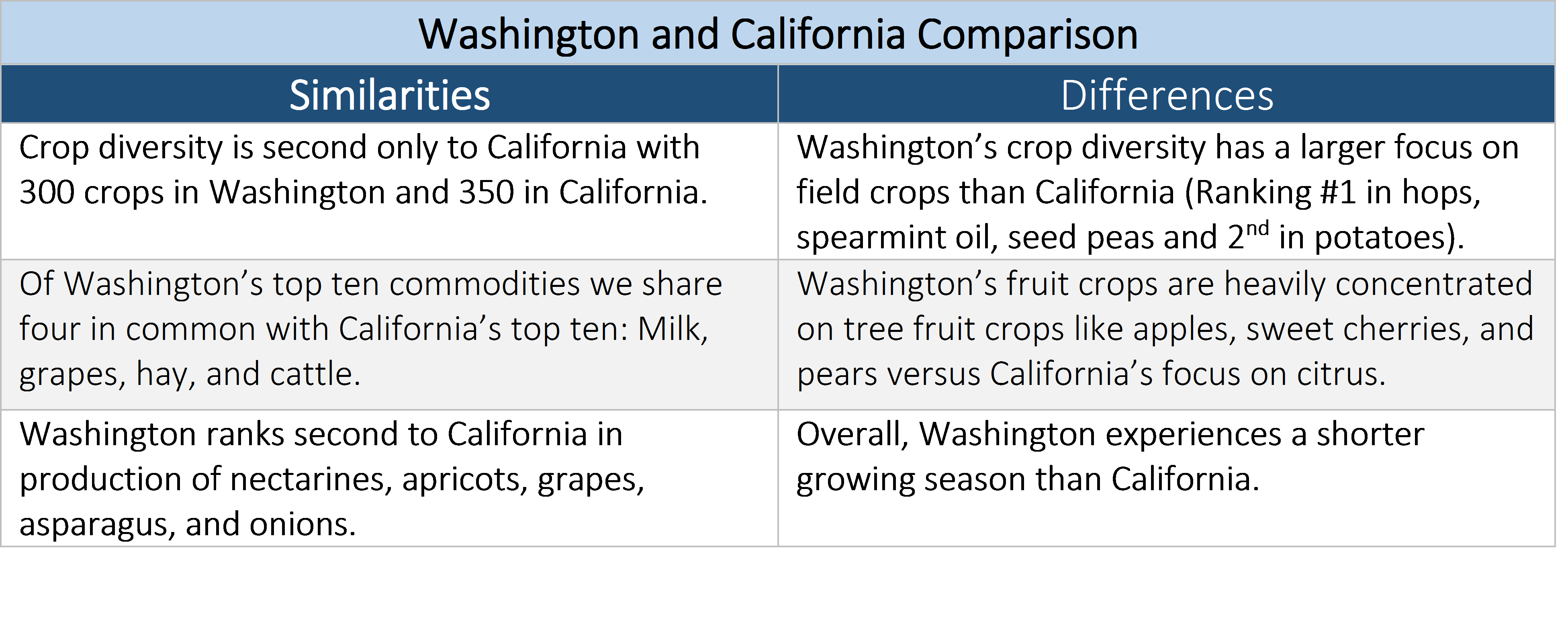Washington agriculture shares many commonalities with California and regulatory issues are no exception. California’s challenges with water availability, water quality and labor issues are often shared with Washington state.
However, despite the many commonalities between Washington and California, solutions need to be tailored to each state because the industries are still very different.

California’s labor laws have migrated to Washington attempting to “fix” the labor “problem”. However, Washington’s unique economy and crops mean our solution to labor challenges needs to be customized to Washington – not copied from California.
Break time rest pay
In 2013, California courts complicated agriculture’s labor system by ruling that “non-productive” time must be compensated separately for piece-rate employees. On October 10, 2015, two 2013 court decisions encouraged California’s Governor signed into law Assembly Bill 1513. The law created the new California Labor Code section 226.2 that requires employers to pay piece-rate employees separately for rest and recovery periods.
Nine days later, Washington State Department of Labor and Industries issued an Administrative Policy on October 19, 2015 regarding “Meal and Rest Periods for Agricultural Workers.” Based on a July 16, 2015 decision in Demetrio v. Sakuma Brothers Farms Inc., the state’s guidance quickly followed California’s example, requiring a separate piece-rate pay for rest periods which “…must equal at least the applicable minimum wage or the pieceworker’s regular rate of pay, whichever is greater.”
Payment on a piece rate was designed to “incentivize employees by awarding harder-working and more productive workers with greater earnings.” The new judicial and legislative decisions in both states complicates labor payment and diminishes the ability of employers to award the hardest working employees.
Agricultural unions
Under the National Labor Relations Act (NLRA) employees and employers are protected from recourse when engaged in collective bargaining to form a union and provides legal certification of unions. However, the agriculture industry is exempted from the NLRA.
Despite that, California became the first major farm state to adopt a rule granting union certification to farm workers in 1975. Per the Agricultural Labor Relations Act (ALRA) of 1975, workers have the rights to decide if they want representation and options to remedy unfair labor practices.
Despite the notoriety of this decision, it has had little success. After 40 years only 20,000 of the estimated 600,000 to 800,000 Californian farm workers are unionized. Many reasons exist for the failure, including poor union leadership, state politics, the changing structure of farm employment, and unauthorized migration. https://s.giannini.ucop.edu/uploads/giannini_public/68/67/6867f6d6-c084-4501-bd23-b348a04a78a4/v15n3_2.pdf
Despite the unsuccessful attempts in California, some in Washington want to promote agricultural unionization. Unlike California, Washington still exists under the NLRA’s agricultural exemption which leaves uncertainty for the industry as farmworker unions in Washington state are not certified. Legislation was attempted in the 1990s but failed and no further efforts have been made.
The September 12th vote to unionize at Sakuma Brothers Farms made them the third agricultural producer in Washington to have a collective bargaining agreement with workers. https://www.king5.com/news/local/sakuma-farmworkers-vote-to-unionize-after-years-of-unrest/318903962
Since Washington is not a “Right To Work” state, this decision means all farmworkers at Sakuma Brothers will be forced to pay dues to the union even if they don’t want to join.
Paid sick-leave
California was also the first to adopt paid sick-leave for all employees under the new law, Healthy Workplaces, Healthy Families Act of 2014, signed on September 10, 2014. The law requires one hour of paid sick leave for every 30 hours worked and allows for six days to roll over every year. However, the law limits the number of annual paid sick days an employee can use per year to three.
Not to be outdone, Washington passed Initiative 1433 in November 2016 allowing for one hour of paid sick leave for every 40 hours worked. Additionally, a worker can rollover 5 days per year. There is no limit on days an employee can use per year.
Overtime exemption for agriculture
Hopefully Washington will refuse to follow California’s new farmworker overtime bill, AB 1066, passed on September 12th, 2016. AB 1066 requires overtime pay for all workers including farm laborers. Previously, farmworkers received overtime after 60 hours per week.
Campaigning under the banner of equality and economic justice, farmworkers achieved their goal of overtime pay after four decades of effort. Unfortunately, for the workers, the disappointing reality of the bill will soon become clear.
Farms are subject to intense seasonality and have high labor demands followed by long downtime. During peaks in labor demand, workers regularly work more than 40 hours per week. No mandates for overtime pay allows farmers to hire workers in excess of forty hours pes week. This allows employees to earn enough income to provide for their families through periods of unemployment during the off-season.
The new overtime law will push farms to hire more labor, limit all workers to 40 hours or less, switch to less labor-intensive crops, move to states with cheaper labor, and invest in mechanization. This will essentially cut the take-home pay for farm employees.
In Washington state where our agricultural industry has more intensive swings in labor demand, an overtime labor law would be even more damaging to farmers and farmworkers.
Conclusion
Washington’s attempt to follow California’s excessive labor regulations will eventually decrease farmworkers’ standard of living. Washington regulators should take the Vegas motto and apply it here, “What happens in California, stays in California.”




